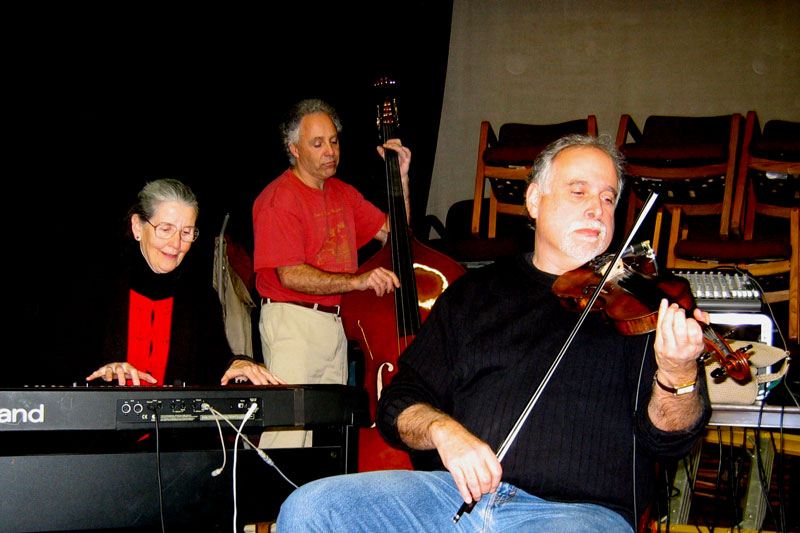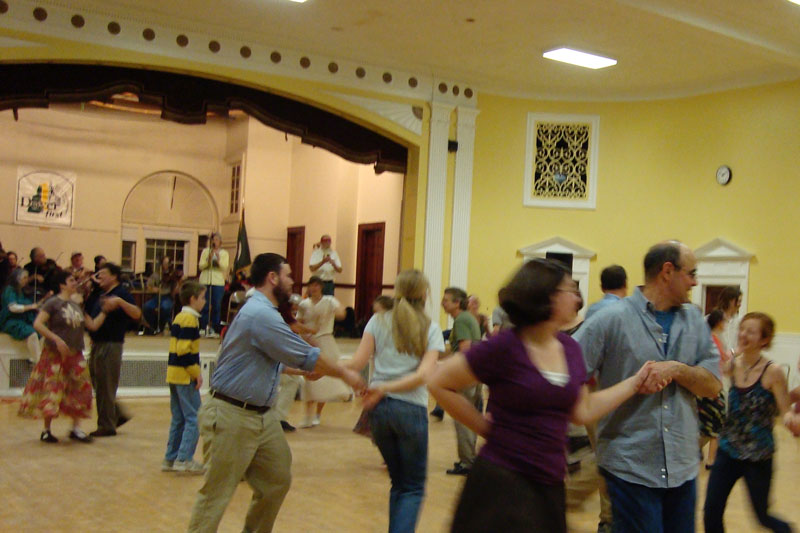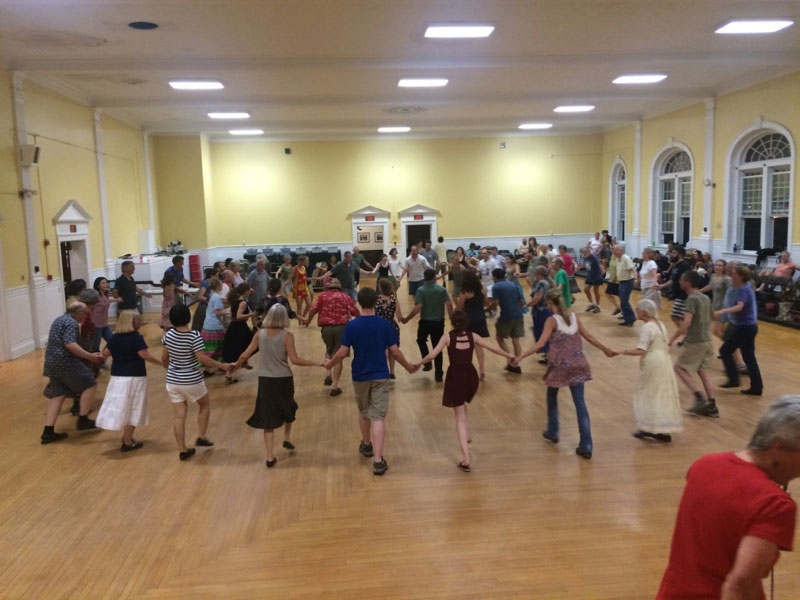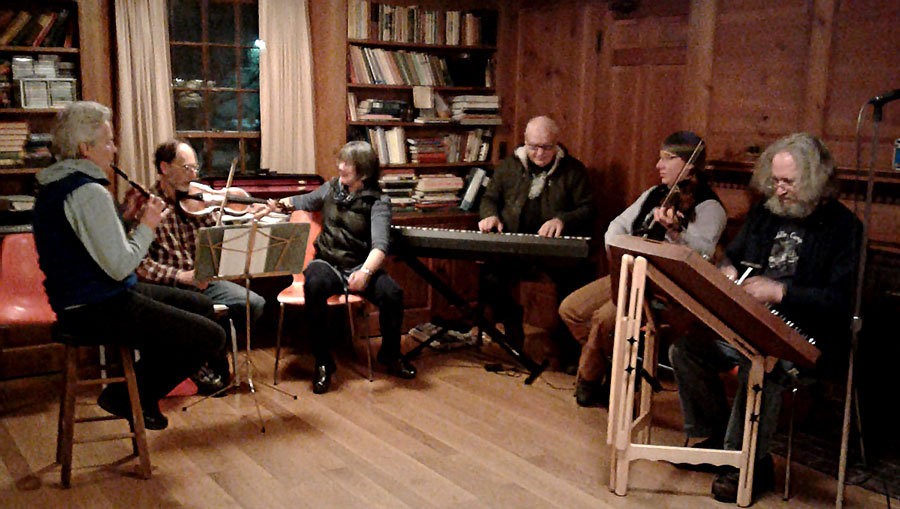New Hampshire Old-Time Country Dance Web Site
The Lamprey River Band

Lamprey River Band II: Its History, Some Stories, and its Impact
This page and the previous page have a pretty thorough although informal history of the Lamprey River Band, including stories about the band, some comments on its impact on Seacoast dancing, and some thoughts on how its origins continue to affect how we do things. Click on the tabs to move through topics.
Sources: There were too many sources to list here, but among the most important were histories of the band in the May 1988 and May 1996 Seacoast Country Dance Newsletter, an essay written in preparation for an interview in 1994, and various band records.
On This Page
This is a fairly extensive section with five tabbed parts. Click on the tabs to move between sections. Here is a brief description of what is in each tab.
Burt's Influence
Burt Feintuch's Influence on the Band
In 1988 Burt Feintuch came to UNH to be the Director of the Center For Humanities. Shortly thereafter I was introduced to him. He was talking to someone I knew right outside of Conant Hall (the Psychology building at that time, where I worked), and I was introduced to him as a new fiddler in the area. I told him about the Lamprey River Band and he expressed interest. Sometime not long after he joined the band.
Burt had a tremendous effect on the band. He first came to New Hampshire from Kentucky, and he was an excellent old-time Southern fiddler with minimal knowledge of New England music. He gradually learned at least some of our repertoire, but rather selectively. There were some tunes he enjoyed playing, but some that he didn’t. Sadly, many of the chestnut contra tunes and most square dance tunes were in that category. As a Southern fiddler he had never played in the flat keys, as that’s not part of most old-time Southern repertoire. He learned to eventually, but that ruled out tunes like Hull’s Victory.
It must be said that he did much better at learning our repertoire than we did at learning his. We learned a few tunes from his Southern repertoire, but he must have cringed when he heard us play them. Most of the band had little background in that style and played the tunes like New England tunes.

Burt Feintuch with Marianne Taylor and Paul DelNero, playing for the Seacoast Holiday Dance, Kingston NH, 12-30-06.
Before Burt joined the band we may have been one of the only bands where the bass player took the lead in choosing tunes. He did so in consultation with other band members, but really Dave was the one who made sure we chose tunes and were ready with a set when the caller was ready to call the next dance. After Burt joined the band he took a much more active role in coming up with sets.
Quite a bit of our repertoire dropped out at that time because Burt didn’t play the tunes. But lacking people to play Southern tunes with, he started getting interested in Cape Breton and Irish music, and brought in quite a large range of tunes over the years. In addition to repertoire, Burt was a very strong fiddler and his style had a major effect on the band sound. Regardless of what he was playing, Burt was an old-time Southern fiddler. His bowing and timing remained strongly Southern-influenced even when he played other types of music. I always enjoyed hearing him play Cape Breton tunes with a Southern accent — although not what some people wanted to hear I always thought it was a great combination. Likewise his New England tunes had somewhat of a Southern accent.
Burt also had a great sense of humor, and it extended to his fiddling. When I called the Crooked Stovepipe we could count on him ending the tune once with a crazy run up to a high note that may or may not really exist (presumably a high G on the E string). He did it with a big grin, and sometimes I had a hard time remembering that I needed to keep calling. He was the one who originated Silent Night as a polka, which we've done every year since at the Seacoast Holiday Dance. At some point Sarah Mason made it known that she was tired of playing the tune Road to Boston. Thereafter, at every dance, Burt made sure we played it at least once through — often while she was calling when the band was about to switch tunes. Of course the fact that Sarah gave such good responses didn't hurt! That became a band institution to the point where it sometimes even happened when Sarah wasn't there. Interestingly, Burt was never comfortable with the idea of trying Road to Boston as a jig, which I always thought would be amusing.
Overall I think it’s fair to say that between repertoire changes, stylistic changes, the strength of his playing and the degree to which he took on a leadership role, it’s reasonable to consider his joining the band a major dividing point in the band’s history, and I think he had a major positive effect on our playing and our overall sound.
Dover Dance
The Dover Dance
The dance ended up moving to the Dover City Hall in September 1992. There is a wonderful dance hall on the second floor, one of the nicest in the state. There was room for the dance to grow even larger. In fact the size of the dance fluctuated considerably, depending on the overall popularity of contradancing and on what else was going on. For example, the Deerfield dance started in January 1992 on the first Saturday of the month, so there were usually two dances on the same weekend. And starting in October 1996 the Dancing Cat dance ran on the fourth Saturday of the month in Dover, bringing in big-name bands and callers just a few days before the first Thursday dance. Needless to say having three local dances generally within a week of each other wasn’t ideal for attendance.
We started out playing and calling from the floor, using the same small stage we used in Madbury, and continued to amplify only the caller. This lasted for the first couple dances, but it didn’t really work; the room was too large and the acoustics were very unfavorable for that. We ended up using the full sound system after a couple months. We did continue to play and call from the floor, which gave us much more contact with the dancers than we’d have had from the stage. Later on we moved up onto the stage, except we continued using the small stage on the floor for the caller.
The rent was higher in Dover than in Madbury, but we got enough dancers to make it viable. We didn’t make more than a few dollars per person most nights, but we had fun and paid the rent.
When we started in Dover we were the only ones in the city hall for most of the dance. It always made me nervous to close up: what if there were someone hiding out in a closet who waited until we left and then broke into one of the rooms where city records were kept? So I was rather relieved when, starting in December 1996, they started hiring a custodian to be there during the dance and to close up at the end.

Dancing in Dover, 2/5/2009.
Unfortunately that raised the rent considerably, and starting in January 1997 the admission doubled to $4 — although that still left it as the dance with the cheapest admission in the state other than the Monday night Nelson dance.
The size of the dance fluctuated, as mentioned previously. There were times when we got as few as 30–40 dancers, and other times when we had between 60 and 110 people monthly, sometimes tending toward the upper end of the range. It was the largest dance in the area for many years.
In January 1998 the rent was raised again and we had to raise the admission to $5. In January 2002 the rent went up again and we raised admission to $6. It went through a few fluctuations, but ended up for many years at $7, or $5 for students. It remained lower than the admission for most other dances.
We went through a period when the attendance was down and we were barely breaking even, sometimes even having to come up with additional money to pay the rent. In the September 2004 Seacoast Country Dance Newsletter I mentioned that due to the high rent and lower than needed attendance we were looking for a new hall for the dance. We looked around, but never really found anyplace that we found acceptable.
But by January 2006 I noted that the dances were much larger, and we no longer had to worry about being able to pay the rent. In fact for a while we were making more than we were paying for the rent. I believe that remained the case for around ten years or so, during which time we were usually on average the largest dance in the area.
Dover Dance, Closer Look
A Closer Look at the Dover Dance
The First Thursday dance has always been different from most other dances in some ways, in most cases deliberately. Here we look at some of those differences, and at other factors that eventually led us to move to Durham.
We started out as a large country dance orchestra with up to a dozen musicians playing for a dance. The band gradually got smaller, but in 1998 we had seven band members, and in 2020 we still have six. Although much of the time we haven’t had an official piano player, we have had someone playing piano or keyboard at nearly every dance we’ve done except the very earliest ones before the days of reasonably affordable quality keyboards when there was no piano in the hall.
The band has generally played in a fairly traditional New England style, without most of the stylistic features adopted by many more modern-sounding bands. We have clear melody, rhythm and phrasing, and don’t downplay any of them. The result is a sound that is fairly different from many of the other bands and combinations of musicians these days. Bands are generally smaller these days, and many bands use guitar for accompaniment rather than piano or keyboard.
We’ve also been open to guest musicians and callers at the First Thursday dance, and at many of our other dances. There have been times when we’ve had close to a dozen sit-in musicians, other times when we’ve had just a couple or even none. But as the practice of encouraging sit-in musicians has become less common overall, we continue to do so.
Our dance repertoire has also been different. We’ve always done chestnut contras, and our modern dances aren’t as modern as what many other callers tend to call. We’ve always done both prompted and singing squares. We did fewer couples dances than we used to in later Dover dances, but we always did a couple. We even did an occasional circle or longways dance. In other words, we have always done a much more traditional dance than many others. In general that’s gone over well with the local dancers.
For several years we had some local high school students attending, and quite a few UNH students. The high school students graduated, and the contradance organization at UNH apparently disappeared shortly after its leaders graduated. We continued to get some UNH students but not as many.
Then a few years ago a dance was started in Portland that ran every Thursday night featuring generally much more modern contras and more modern-sounding music They sometimes have very good more traditional musicians like Don and Cindy Roy, so I would assume that although I don’t know about them, the more modern bands are probably very good too. This dance attracted many of the younger dancers that were going to our dance, and some of the more long-term dancers as well; and as they were going there the rest of the month they didn’t come to the Dover dance the one week it happened.

The Dover hall is one of the nicest around to dance in. Here's a photo of people dancing in Dover at the August 2015 dance.
So various factors combined to bring our dance back down to the point of just barely breaking even. It was still about as big as the other local dances (generally between 35 and 60 dancers), but our rent was higher.
We were still quite cheerfully continuing in Dover, but then in summer of 2018 Burt got sick and had to miss the dance. It turned out to be a cancer, and he died at the end of October. This was quite a shock to all of us, and made us question whether we wanted to continue. There were two practical issues besides the shock of losing Burt. One was that he was our lead fiddler and a large part of the Lamprey River Band sound. The other was that he knew how to use the fairly new sound system much better than anyone else.
The band had discussions at a meeting and online, and we decided that we wanted to continue playing together; but we also decided that we didn’t want anything that was as much work as the Dover dance to set up and take down, we didn’t want to deal with the weight and complexities of our sound system, and we didn’t want to continue having to worry about at least breaking even. We looked around and there still weren’t many choices.
1st Thursdays in Durham
First Thursdays in Durham
One of the few choices that turned out to be available was the Unitarian Fellowship in Durham. I had run a jam session there for years (which I’m sure will be discussed elsewhere in the website), and Dudley Laufman had run a monthly dance there when I first started dancing in the late 1970s. It’s a very nice hall, but small; it can hold a couple squares and one or two contra lines. So moving there would mean a radical change to the dance.

The Lamprey River Band playing at the first Durham dance, March 2019. Photo by Glenn Coppelmann.
There was also the issue of the music. No one could replace Burt either as a person or as a musician. But my partner Emeline Dehn-Reynolds had been coming to our dances for several years and sitting in with the band so she knew many of our tunes and is an excellent fiddler. She has ended up being our new lead fiddler. This works well for me because unlike Burt or most of the rest of the band she knows and is happy to play near all the tunes for the chestnut contras and for many singing square dances.
We decided to do it, and on February 7, 2019 we had the last dance in Dover. It was an excellent dance, and we were all sad to leave. On Thursday March 7 we had the first dance in Durham. We were honored to have Dudley Laufman show up and call the Monadnock Reel, as well as tell a few stories. It was a much smaller dance, but we filled the hall, and everyone seemed to have a good time.
The Durham dance is rather different than the Dover dance. We don’t use a sound system except that I use my old monitor speaker to amplify the caller. But without all the sound equipment we can fit into a corner of the hall, and we hear each other better than we ever did in Dover, and the dancers hear us very well. Sarah Mason is taking a break from calling so other than if we get a guest caller I call the dance. Between the setting and having Emeline fiddling, I’ve ended up calling many more chestnut contras than before, and doing more couples dances as well. I’ve even done dances like the Roberts. The Dover dance was always a friendly dance; sometimes I’d have to work to get people to line up for the next dance because they were too busy socializing. But the smaller size of the Durham dance makes it friendly in a way that’s not possible for a larger dance; and the band is much more a part of the group. It doesn’t appeal to everyone, but we’ve had enough people for it to feel right for the hall each time, and everyone who comes seems to have a good time.